组织行为学 能力(一)
- 格式:pptx
- 大小:714.90 KB
- 文档页数:7
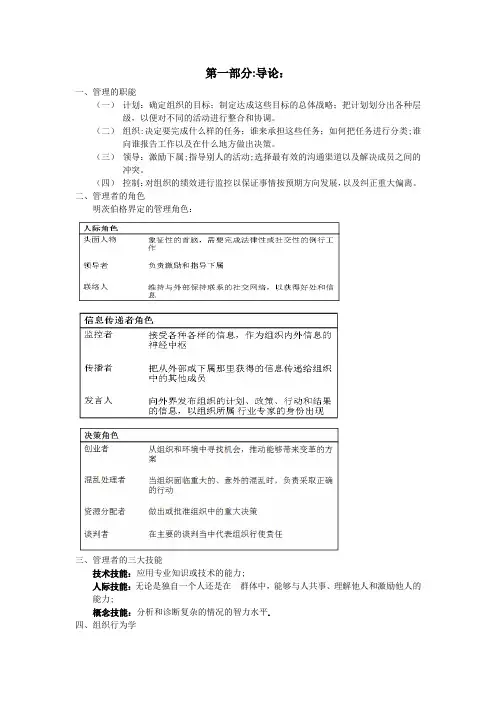
第一部分:导论:一、管理的职能(一)计划:确定组织的目标;制定达成这些目标的总体战略;把计划划分出各种层级,以便对不同的活动进行整合和协调。
(二)组织:决定要完成什么样的任务;谁来承担这些任务;如何把任务进行分类;谁向谁报告工作以及在什么地方做出决策。
(三)领导:激励下属;指导别人的活动;选择最有效的沟通渠道以及解决成员之间的冲突。
(四)控制:对组织的绩效进行监控以保证事情按预期方向发展,以及纠正重大偏离。
二、管理者的角色明茨伯格界定的管理角色:三、管理者的三大技能技术技能:应用专业知识或技术的能力;人际技能:无论是独自一个人还是在群体中,能够与人共事、理解他人和激励他人的能力;概念技能:分析和诊断复杂的情况的智力水平.四、组织行为学(一)含义:组织行为学 (OB)是研究组织中人的心理行为规律的一门科学,它探讨个体、群体以及结构对组织内部行为的影响,目的是应用这些知识改善组织绩效。
(二)组织行为学的研究(1)三个层次:个体群体组织(2)基本模型:A.因变量:一个受某自变量影响的反应(也是组织行为研究者想了解的).生产率:对效果(实现目标)和效率(以低成本实现目标)两方面的测量。
缺勤率:指的是没来上班的现象流动率:指员工永久地离开一个组织,这可能是主动行为也可能是非主动行为工作场所中的越轨行为:违反重要的组织规则,从而威胁组织和个人健康的主动性行为组织公民行为:是一种由员工自由决定的行为,它不包括在员工的正式工作要求当中,但这种行为无疑会促进组织的有效运作和作用工作满意度:代表的是态度而不是行为;由于对工作特点进行评估而产生的对工作的积极感觉B.自变量:因变量变化的假设性原因; 因变量的主要决定因素(3)研究方法:(4)历史发展(了解)第二部分:个体一、传记特征:对人的了解,最简单的、最容易得到的就是其基本状况信息,比如年龄、性别、婚姻状况等等。
这些信息被成为传记特点(biographical characteristics)。

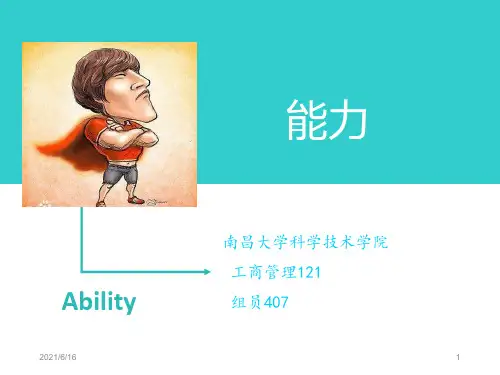
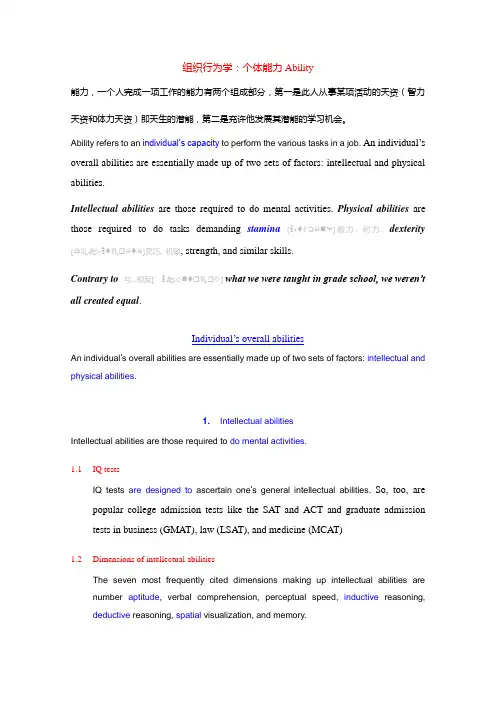
组织行为学:个体能力Ability能力,一个人完成一项工作的能力有两个组成部分,第一是此人从事某项活动的天资(智力天资和体力天资)即天生的潜能,第二是充许他发展其潜能的学习机会。
Ability refers to an individual’s capacity to perform the various tasks in a job. An individual’s overall abilities are essentially made up of two sets of factors: intellectual and physical abilities.Intellectual abilities are those required to do mental activities. Physical abilities are those required to do tasks demanding stamina[ ♦♦✌❍♓⏹☜]毅力, 耐力,dexterity [♎♏♦♦♏❒♓♦♓]灵巧, 机敏, strength, and similar skills.Contrary to与...相反[ ⏹♦❒♏❒✋] what we were taught in grade school, we weren’t all created equal.Individual’s overall abilitiesAn individual’s overall abilities are essentially made up of two sets of factors: intellectual and physical abilities.1. Intellectual abilitiesIntellectual abilities are those required to do mental activities.1.1IQ testsIQ tests are designed to ascertain one’s general intellectual abilities. So, too, are popular college admission tests like the SAT and ACT and graduate admission tests in business (GMAT), law (LSAT), and medicine (MCAT)1.2Dimensions of intellectual abilitiesThe seven most frequently cited dimensions making up intellectual abilities are number aptitude, verbal comprehension, perceptual speed, inductive reasoning, deductive reasoning, spatial visualization, and memory.(1)Number aptitudeAbility to do speedy and accurate arithmetic__ Job example: accountant __ computing the sales tax on a set of items(2)Verbal comprehensionAbility to understand what is read or heard and the relationship of words to each other __ Job example: plant manager __following corporate policies(3)Perceptual speedAbility to identify visual similarities and differences quickly and accurately __ Job example: fire investigator __identifying clues to support a charge of arson (4)Inductive reasoningAbility to identify a logical sequence in a problem and then solve the problem __ Job example: market researcher: forecasting demand for a product in the next time period(5)Deductive reasoningAbility to use logic and assess the implications of an argument__ Job example: supervisor __choosing between two different suggestions offered by employees (6)Spatial visualizationAbility to imagine how an object would look if its position in space were changed__ Job example: interior decorator ___redecorating an office(7)MemoryAbility to retain and recall past experiences __Job example: salesperson __remembering the names of customersJobs differ in the demands they place on incumbents to use their intellectual abilities. Generally speaking, the more information processing demands that exist in a job, the more general intelligence and verbal abilities will be necessary to perform the job successfully.A high IQ is not a prerequisite for all jobs. In fact, for many jobs — where employee behavior is highly routine and there are little or no opportunities to exercise discretion —a high IQ may be unrelated to performanceThe major dilemma faced by employers who use mental ability tests for selection, promotion, training, and similar personnel decisions is that they may have a negativeimpact on racial and ethnic groups. The evidence indicates that some minority groups score, on the average, as much as one standard deviation lower than whites on verbal, numerical, and spatial ability tests.2. Physical abilitiesPhysical abilities are those required to do tasks demanding stamina,dexterity, strength, and similar skills. Contrary to与...相反what we were taught in grade school, we were not all created equal. 【stamina[ ♦♦✌❍♓⏹☜]毅力, 耐力__dexterity[♎♏♦♦♏❒♓♦♓]灵巧, 机敏__contrary __】Specific physical abilities gain importance for successfully doing less skilled and more standardized jobs.Nine basic physical abilitiesResearch on the requirements needed in hundreds of jobs has identified nine basic abilities involved in the performance of physical tasks.•Strength factors(1)Dynamic strengthAbility to exert muscular force repeatedly or continuously over time(2)Trunk strengthAbility to exert muscular strength using the trunk, particularly abdominal,muscles(3)Static strengthAbility to exert force against external objects(4)Explosive strengthAbility to expend a maximum of energy in one or a series of explosive acts •Flexibility factors(5)Extent flexibilityAbility to move the trunk and back muscles as far as possible(6)Dynamic flexibilityAbility to make rapid, repeated flexing movements•Other factors(7)Body coordinationAbility to coordinate the simultaneous actions of different parts of the body(8)BalanceAbility to maintain equilibrium despite forces pulling off balance(9)StaminaAbility to continue maximum effort requiring prolonged effort over time Source: reprinted from the June 1979 issue of Personnel Administrator, copyright 1979, theAmerican Society for Personnel Administration; 606 North Washington Street, Alexandria,Virginia 22314, pp. 82~92Individuals differ in the extent to which they have each of these abilities. Not surprisingly, there is also little relationship between them: a high score on one is no assurance of a high score on others.High employee performance is likely to be achieved when management has ascertained the extent to which a job requires each of the nine abilities and then ensures that employees in that job have those abilities.Ability-job fitWe have demonstrated that jobs make differing demands on people and that people differ in the abilities they possess. Employee performance, therefore, is enhanced when there is a high ability-job fit.【make demands on ①对...提出要求;②有求于】The specific intellectual or physical abilities required for adequate job performance depend on the ability requirements of the job.So, for example, airline pilots need strong spatial visualization abilities; senior executives need verbal abilities; executives need verbal abilities; high-rise construction workers need balance. Directing attention at only the employee’s abilities or the ability requirements of the job ignores that employee performance depends on the interaction of the two.When the ability-job fit is out of sync because the employee has abilities that far exceed the requirements of the job, our predictions would be very different. Given that pay tends to reflect the highest skill level that employees possess, if an employee’s abilities far exceed those necessary to do the job, management will be paying more than it needs to. Abilitiessignificantly above those required can also reduce the employee’s job satisfaction when employee’s desire to use his abilities is particularly strong and is frustrated by the limitations of the job.What predictions can we make when the fit is poor?If employees lack the required abilities, they are likely to fail.When the ability-job fit is out of sync because the employee has abilitiesthat far exceed the requirements of the job, our predictions would be verydifferent.Job performance is likely to be adequate, but there will be organizationalinefficiencies and possible declines in employee satisfaction. Given thatpay tends to reflect the highest skill level that employees possess, if anemployee’s abilities far exceed those necessary to do the job, managementwill be paying more than it needs to.Abilities significantly above those required can also reduce theemployee’s job satisfaction when the employee’s desire to use his or herabilities is particularly strong and is frustrated by the limitations of thejob.。
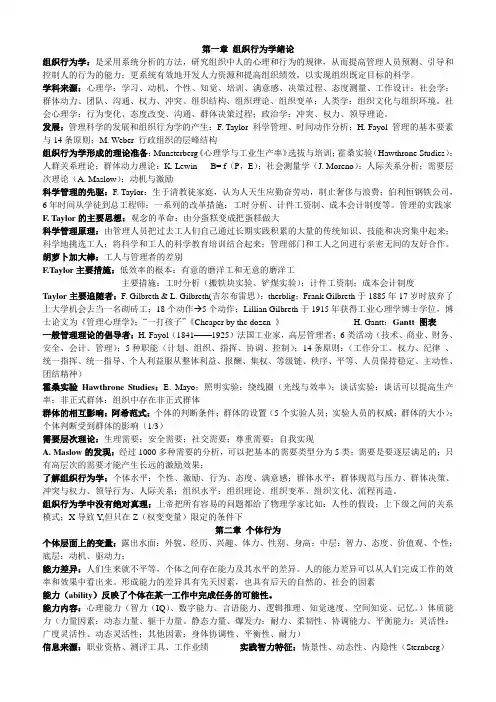
第一章组织行为学绪论组织行为学:是采用系统分析的方法,研究组织中人的心理和行为的规律,从而提高管理人员预测、引导和控制人的行为的能力;更系统有效地开发人力资源和提高组织绩效,以实现组织既定目标的科学。
学科来源:心理学:学习、动机、个性、知觉、培训、满意感、决策过程、态度测量、工作设计;社会学:群体动力、团队、沟通、权力、冲突、组织结构、组织理论、组织变革;人类学:组织文化与组织环境。
社会心理学:行为变化、态度改变、沟通、群体决策过程;政治学:冲突、权力、领导理论。
发展:管理科学的发展和组织行为学的产生:F. Taylor 科学管理、时间动作分析;H. Fayol 管理的基本要素与14条原则;M. Weber 行政组织的层峰结构组织行为学形成的理论准备:Munsterberg《心理学与工业生产率》选拔与培训;霍桑实验(Hawthrone Studies):人群关系理论;群体动力理论:K. Lewin B= f(P,E);社会测量学(J. Moreno):人际关系分析;需要层次理论(A. Maslow):动机与激励科学管理的先驱:F. Taylor:生于清教徒家庭,认为人天生应勤奋劳动,制止奢侈与浪费;伯利恒钢铁公司,6年时间从学徒到总工程师;一系列的改革措施:工时分析、计件工资制、成本会计制度等。
管理的实践家F. Taylor的主要思想:观念的革命:由分蛋糕变成把蛋糕做大科学管理原理:由管理人员把过去工人们自己通过长期实践积累的大量的传统知识、技能和决窍集中起来;科学地挑选工人;将科学和工人的科学教育培训结合起来;管理部门和工人之间进行亲密无间的友好合作。
胡萝卜加大棒:工人与管理者的差别F.Taylor主要措施:低效率的根本:有意的磨洋工和无意的磨洋工主要措施:工时分析(搬铁块实验、铲煤实验);计件工资制;成本会计制度Taylor主要追随者:F. Gilbreth & L. Gilbreth(吉尔布雷思):therblig;Frank Gilbreth于1885年17岁时放弃了上大学机会去当一名砌砖工;18个动作 5个动作;Lillian Gilbreth于1915年获得工业心理学博士学位,博士论文为《管理心理学》;“一打孩子”《Cheaper by the dozen 》H. Gantt:Gantt 图表一般管理理论的倡导者:H. Fayol(1841——1925)法国工业家,高层管理者;6类活动(技术、商业、财务、安全、会计、管理);5种职能(计划、组织、指挥、协调、控制);14条原则:(工作分工、权力、纪律、统一指挥、统一指导、个人利益服从整体利益、报酬、集权、等级链、秩序、平等、人员保持稳定、主动性、团结精神)霍桑实验Hawthrone Studies:E. Mayo;照明实验:绕线圈(光线与效率);谈话实验:谈话可以提高生产率;非正式群体:组织中存在非正式群体群体的相互影响:阿希范式:个体的判断条件;群体的设置(5个实验人员;实验人员的权威;群体的大小);个体判断受到群体的影响(1/3)需要层次理论:生理需要;安全需要;社交需要;尊重需要;自我实现A. Maslow的发现:经过1000多种需要的分析,可以把基本的需要类型分为5类;需要是要逐层满足的;只有高层次的需要才能产生长远的激励效果;了解组织行为学:个体水平:个性、激励、行为、态度、满意感;群体水平:群体规范与压力、群体决策、冲突与权力、领导行为、人际关系;组织水平:组织理论、组织变革、组织文化、流程再造。
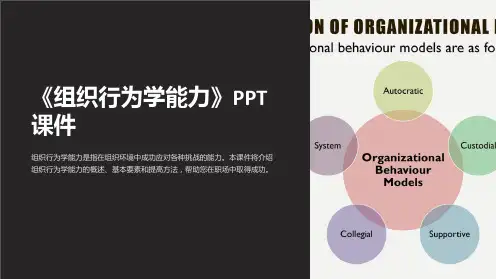

精心整理《领导力与组织行为能力》职业测评测量控制点测量对以下10个问题中的每一个,用以下的量表对其内容作出同意或不同意的表示。
其中,1=非常不同意,2=不同意,3=有些不同意,4=无所谓,5=有些同意,6=同意,7=非常同意。
计分:其中第3、6、7、8、10是反向记分题。
(l=7,2=6.3=5,4=4,5=3,6=2,7=1)。
如第3题您是“非常不同意”您可得“l”分,由于该题是反向题。
因此将“1”分改成“7”分。
对第6、7、8、10题可用同样方法作反向记分。
将10道题得分相加即为量表总分。
您的得分:________52.2。
1.找出每组(用线分隔的)第一排题目你所选择的数字,并求和(第1排+第6排-第11排+第16排+第21排=_)。
这是你的“适应性”原始分。
圈出转换表中“适应性”一列对应于原始分的标准分。
2.找出每组(用线分隔的)第一排题目你所选择的数字,并求和(第2排+第7排+第12排+第17排+第22排=_)。
这是你的“社交性”原始分。
圈出特换表中“社交性”一列对应于原始分的标准分。
3.找出每组(用线分隔的)第一排题目你所选择的歌字,并求和(第3排+第8排+第13排+第18排+第23排=_)。
这是你的“开放性”4.找出每组(用线分隔的)(第4排+第9排+第14排+第195.找出每组(用线分隔的)(第56中。
7A型—B型人格自测为了考察您属于A型人格还是B型人格,请在下面各个维度的连续数字中最能代表您的行为数字上面画圈(其中两端的语言描述极端的情况)将各个选项分数相加,您的总分是______,乘以3之后等于______。
对您的分数的解释如下:个体需要类型调查问卷人的需要。
各个陈述有73”那儿画一个圈。
要求大约在101,4,16,20)、安全需要(2,7,12,15)、自尊需要(6,8,14,1713,18)。
将各个题项的得分相加洛需要层次理论中的5种需要的相对重视程度。
情商(EQ)测试指导语:根据自身实际情况选择对以下的十个陈述作回答。

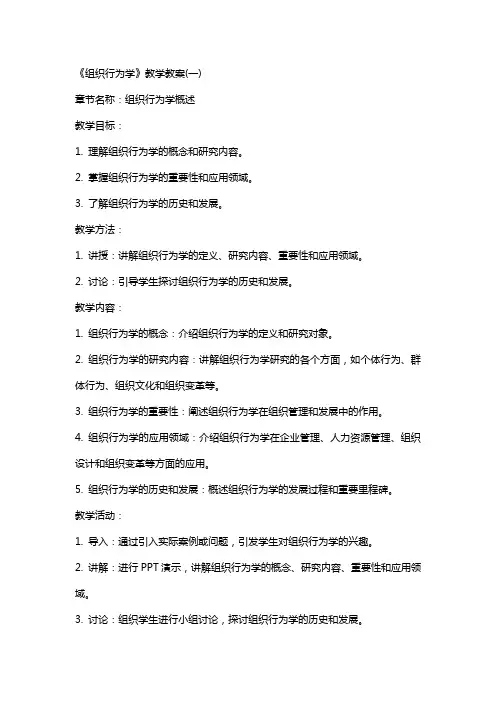
《组织行为学》教学教案(一)章节名称:组织行为学概述教学目标:1. 理解组织行为学的概念和研究内容。
2. 掌握组织行为学的重要性和应用领域。
3. 了解组织行为学的历史和发展。
教学方法:1. 讲授:讲解组织行为学的定义、研究内容、重要性和应用领域。
2. 讨论:引导学生探讨组织行为学的历史和发展。
教学内容:1. 组织行为学的概念:介绍组织行为学的定义和研究对象。
2. 组织行为学的研究内容:讲解组织行为学研究的各个方面,如个体行为、群体行为、组织文化和组织变革等。
3. 组织行为学的重要性:阐述组织行为学在组织管理和发展中的作用。
4. 组织行为学的应用领域:介绍组织行为学在企业管理、人力资源管理、组织设计和组织变革等方面的应用。
5. 组织行为学的历史和发展:概述组织行为学的发展过程和重要里程碑。
教学活动:1. 导入:通过引入实际案例或问题,引发学生对组织行为学的兴趣。
2. 讲解:进行PPT演示,讲解组织行为学的概念、研究内容、重要性和应用领域。
3. 讨论:组织学生进行小组讨论,探讨组织行为学的历史和发展。
4. 总结:对本次课程进行总结,强调组织行为学的重要性和应用领域。
教学评估:1. 课堂参与度:观察学生在讨论中的积极参与程度和表现。
2. 小组讨论报告:评估学生对组织行为学历史和发展的理解和分析能力。
《组织行为学》教学教案(二)章节名称:个体行为分析教学目标:1. 理解个体行为的概念和特点。
2. 掌握个体行为分析的方法和技巧。
3. 了解个体行为对组织的影响。
教学方法:1. 讲授:讲解个体行为的概念、特点和影响因素。
2. 案例分析:分析实际案例,引导学生理解个体行为分析的方法和技巧。
教学内容:1. 个体行为的概念:介绍个体行为的定义和特点。
2. 个体行为分析的方法:讲解个体行为分析的常用方法,如心理分析、行为科学和人力资源管理等。
3. 个体行为分析的技巧:介绍个体行为分析的实用技巧,如观察、调查和数据分析等。
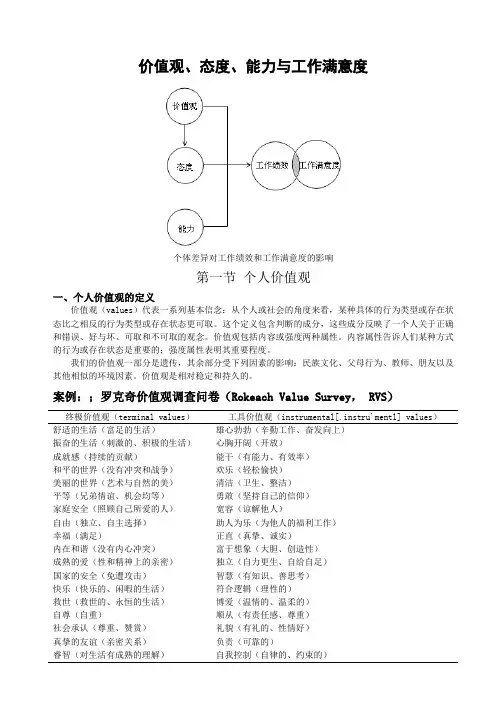
价值观、态度、能力与工作满意度个体差异对工作绩效和工作满意度的影响第一节个人价值观一、个人价值观的定义价值观(values)代表一系列基本信念:从个人或社会的角度来看,某种具体的行为类型或存在状态比之相反的行为类型或存在状态更可取。
这个定义包含判断的成分,这些成分反映了一个人关于正确和错误、好与坏、可取和不可取的观念。
价值观包括内容或强度两种属性。
内容属性告诉人们某种方式的行为或存在状态是重要的;强度属性表明其重要程度。
我们的价值观一部分是遗传,其余部分受下列因素的影响:民族文化、父母行为、教师、朋友以及其他相似的环境因素。
价值观是相对稳定和持久的。
案例:;罗克奇价值观调查问卷(Rokeach Value Survey, RVS)终极价值观(terminal values)工具价值观(instrumental[.instru'mentl] values)舒适的生活(富足的生活)雄心勃勃(辛勤工作、奋发向上)振奋的生活(刺激的、积极的生活)心胸开阔(开放)成就感(持续的贡献)能干(有能力、有效率)和平的世界(没有冲突和战争)欢乐(轻松愉快)美丽的世界(艺术与自然的美)清洁(卫生、整洁)平等(兄弟情谊、机会均等)勇敢(坚持自己的信仰)家庭安全(照顾自己所爱的人)宽容(谅解他人)自由(独立、自主选择)助人为乐(为他人的福利工作)幸福(满足)正直(真挚、诚实)内在和谐(没有内心冲突)富于想象(大胆、创造性)成熟的爱(性和精神上的亲密)独立(自力更生、自给自足)国家的安全(免遭攻击)智慧(有知识、善思考)快乐(快乐的、闲暇的生活)符合逻辑(理性的)救世(救世的、永恒的生活)博爱(温情的、温柔的)自尊(自重)顺从(有责任感、尊重)社会承认(尊重、赞赏)礼貌(有礼的、性情好)真挚的友谊(亲密关系)负责(可靠的)睿智(对生活有成熟的理解)自我控制(自律的、约束的)研究证实,相同职业或类别的人倾向于拥有相同的价值观。
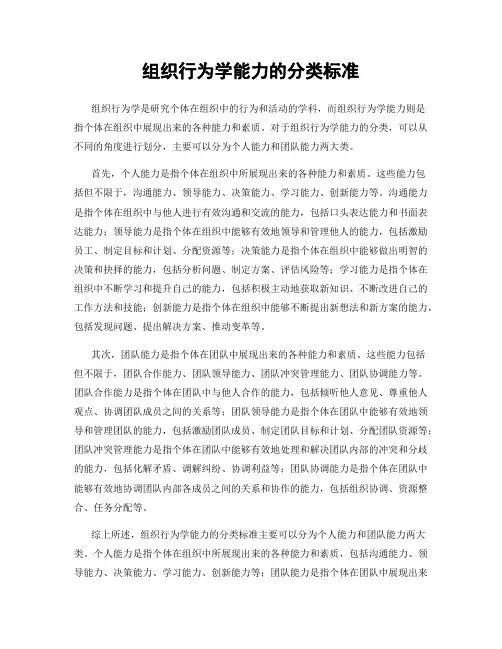
组织行为学能力的分类标准组织行为学是研究个体在组织中的行为和活动的学科,而组织行为学能力则是指个体在组织中展现出来的各种能力和素质。
对于组织行为学能力的分类,可以从不同的角度进行划分,主要可以分为个人能力和团队能力两大类。
首先,个人能力是指个体在组织中所展现出来的各种能力和素质。
这些能力包括但不限于,沟通能力、领导能力、决策能力、学习能力、创新能力等。
沟通能力是指个体在组织中与他人进行有效沟通和交流的能力,包括口头表达能力和书面表达能力;领导能力是指个体在组织中能够有效地领导和管理他人的能力,包括激励员工、制定目标和计划、分配资源等;决策能力是指个体在组织中能够做出明智的决策和抉择的能力,包括分析问题、制定方案、评估风险等;学习能力是指个体在组织中不断学习和提升自己的能力,包括积极主动地获取新知识、不断改进自己的工作方法和技能;创新能力是指个体在组织中能够不断提出新想法和新方案的能力,包括发现问题、提出解决方案、推动变革等。
其次,团队能力是指个体在团队中展现出来的各种能力和素质。
这些能力包括但不限于,团队合作能力、团队领导能力、团队冲突管理能力、团队协调能力等。
团队合作能力是指个体在团队中与他人合作的能力,包括倾听他人意见、尊重他人观点、协调团队成员之间的关系等;团队领导能力是指个体在团队中能够有效地领导和管理团队的能力,包括激励团队成员、制定团队目标和计划、分配团队资源等;团队冲突管理能力是指个体在团队中能够有效地处理和解决团队内部的冲突和分歧的能力,包括化解矛盾、调解纠纷、协调利益等;团队协调能力是指个体在团队中能够有效地协调团队内部各成员之间的关系和协作的能力,包括组织协调、资源整合、任务分配等。
综上所述,组织行为学能力的分类标准主要可以分为个人能力和团队能力两大类。
个人能力是指个体在组织中所展现出来的各种能力和素质,包括沟通能力、领导能力、决策能力、学习能力、创新能力等;团队能力是指个体在团队中展现出来的各种能力和素质,包括团队合作能力、团队领导能力、团队冲突管理能力、团队协调能力等。
电大《组织行为学》形考任务1-4答案《组织行为学》形考任务一一、案例分析:XXX答:(1)从案例我们可以看出XXX目光远大,办事果断,懂得人才开发的重要,充分重视人的作用。
对于人的使用,自始至终充满尊重、理解和信赖。
XXX认为,公司是人组成的,能不能把每个员工的积极性发挥出来,将关系到公司的成败。
平日里,XXX从不插手一个具体项目的日常管理工作,只是在他认为非要他管不可的时候,他才露面。
而且公司内部每一个员工的意见他都爱听。
公司很少解雇员工,他以最大努力发挥公司里每一个人的积极性。
根据西方人性假设理论,XXX的人性观属于“自我实现人性的假设”。
此假设认为:第一、工作可以成为满意的源泉;第二、人们在实现他们所承诺的目标任务时,会进行自我管理和自我控制;第三、对目标、任务的承诺取决于实现这些目标、任务后能得到的报偿的大小;第四、在适当条件下,一般的人不但懂得接受,而且懂得去寻求负有职责的工作;第五、在解决组织问题时,大多数人具有运用相对而言的高度想象力、机智和创造性的能力。
(2)如果用M=E*V来表示XXX激励员工的进程,那么这个模型中目标是自我完成、变量是XXX和员工,关系是尊重、理解和信任。
激发力量=效价×期望值(M=V.E)M代表激发力量的高低,是指念头的强度,即调动一小我积极性,激发其内在潜力的强度。
它表明人们为到达设置的目标而努力的水平。
V代表效价,是指目标关于满足小我需要的价值,即一小我对某一结果偏爱的强度。
(—1≤V≤1)。
E代表期望值,是指采取某种行为可能导致的绩效和满足需要的概率。
即采取某种行为对完成目标可能性的大小。
(≤E≤1)。
二、案例分析:研究所里来了个老费答:1、老费:从XXX可看出属外倾型性格,他与人交往性情开朗而活跃,善于表露情感、表现自己的独立行为,工作勤奋;他知识渊博,工作能力强,有责任心;有个性,不愿受约束,也不修边幅。
XXX:从文中可看出属内倾型性格,他与人交往显得沉静,不善于表露情感、表现自己的行为,遇到问题好思考,做事总是三思而后行;他工作责任性强,有事业心,也有一定的工作能力,希望有所成就,得到晋升、提拔,并把晋升看得非常重要。
组织行为学一、填空题1、我们把组织行为分为三个层次。
在第一个层次上,把组织看成追求组织目标而工作的个人的集合.在第二个层次上,重在分析组织成员在群体工作中的相互影响。
在第三个层次上,把组织视为一个整体来分析组织行为。
2、人的一切活动都是为了满足自己的需求,需求是人的行为的出发点,因此,研究需求、动机与行为的关系也是激励理论的基础.组织目标的实现最终取决于组织成员的个人努力程度,如何调动个体的积极性是组织管理中最重要的问题,是激励理论的核心。
为此,只有了解人的需求和动机的规律性,才能预测人的行为,进而引导人的行为,调动人的积极性,使之朝着达成组织目标的方向发展。
3、人的一切活动都是为了满足自己的需求,需求是人的行为的出发点,因此,研究需求、动机与行为的关系也是激励理论的基础。
4、态度是一种较为持久的感觉、信念和行为倾向,针对的是具体的人、群体、观点、事件或事物。
态度是由认知因素上筵盟L知识)、情感因素(感觉、情感)和行为因素(以某种方式行事的倾向)组成的.5、双因素理论又称为激励一保健理论,是美国心理学家弗雷德里克·赫莎伯格(Herzberg).提出的.与马斯洛和麦克利兰的理论相似,该理论也试图说明员工们重视某些与工作绩效有关的因素。
6、群体是有结构的,群体结构塑造着群体成员的行为,并有助于解释和预测群体内的个体行为和群体绩效。
群体的结构变鼓主要包括群体角色、群体规范、群体地化群体规模、群体构成及群体凝聚力。
7、泰勒在《科学管理原理》一书中就指出:“工业界的领袖人物是天生的,不是培养出来的.8、乡村俱乐部型(1,9)。
强调满足人的需求,认为只要职工的心情舒畅,生产就一定能搞好;而对指挥、监督和规章制度都不够重视.领导人为了保持与同事及下级间良好感情而不惜使生产受损。
9、领导生命周期理论包括两项要素:工作成熟度与心理成熟度.前者包括一个人的知识和技能。
工作成熟度高的个体拥有足够的知识、能力和经验完成工作任务而不需要他人的指导;后者指的是一个人做某事的意愿和动机。
1.不善于表露情感、表现行为,与人交往显得沉静而孤僻,这种性格类型是( )。
A.情绪型B.外倾型C.内倾型D.顺从型答案:C2.个体在社会化的过程中,不断地被灌输和强调这样一种观念从而影响个体遵从组织的程度叫做( )。
A.连续承诺B.规范承诺C.职业承诺D.情感承诺答案:B3.负责同他所领导的组织内外无数个个人和团体维持关系,建立和发展一种特别的联系网络,将组织与环境联结起来的角色是( )。
A.监听者B.联络者C.发言人D.传播者答案:B4.( )认为人的行为是环境与个体相互作用的结果,于1951年提出了著名的人类行为公式。
A.维纳B.斯金纳C.卢因D.罗可齐答案:C5.在时间、空间上接近的对象,有被知觉为同类的倾向是因为( )。
A.连续律B.接近律C.相似律D.闭锁律答案:B6.行为的理论模式用函数关系式表达为( )。
A.B=f(S·P)B.B=f(P·E)C.B=f(S·E)D.B=f(P·M)答案:B7.通过阅读杂志和与他人谈话来了解公众兴趣的变化、竞争对手可能的打算等,属于( )角色。
A.领导者B.人际关系C.联络者D.监听者答案:D8.归因理论是在美国心理学家海德的( )和人际关系理论的基础上,经过美国斯坦福大学教授罗斯和澳大利亚心理学家安德鲁斯等人的推动而发展壮大起来的。
A.社会比较理论B.需要层次理论C.社会认知理论D.人力资本理论答案:C9.“社会人”假设是梅奥等人依据( )的结果提出来的。
这一假设认为,人们最重视的是工作中与周围人友好相处,物质利益是相对次要的因素。
A.霍桑试验B.搬运铁砂实验C.照明实验D.阿希实验答案:A10.人际技能是指与处理( )有关的技能,即理解、激励他人并与他人共事的能力。
A.人际关系B.人事关系C.人物关系D.人职关系答案:B11.所谓( )的假定认为,人在本能上确有多种需要,也希望自己的需要不断得到满足,然而,作为一个人,更重要的是有着自己的信仰和价值观。